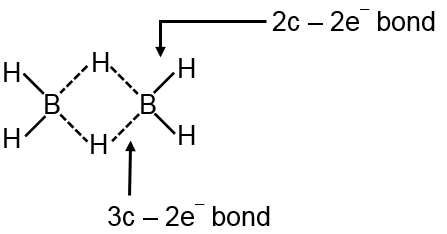To determine the number of 2-centre-2-electron (2c-2e) and 3-centre-2-electron (3c-2e) bonds in diborane (B2H6), we need to understand its structure and bonding.
Structure of Diborane (B2H6):
Diborane has a unique structure with two boron atoms and six hydrogen atoms. It contains two types of hydrogen atoms:
- Terminal hydrogens: Four hydrogen atoms that are bonded normally to boron atoms.
- Bridge hydrogens: Two hydrogen atoms that form bridges between the two boron atoms.
Bonding in Diborane:
The bonding involves:
- 2c-2e bonds: These are conventional bonds where two atoms share two electrons. In B2H6, there are four B-H terminal bonds, each being a 2c-2e bond.
- 3c-2e bonds: These are bonds where three atoms (two boron and one hydrogen) share two electrons. In B26, the two bridge hydrogens form two such bonds (each bridge H is part of one 3c-2e bond).
Counting the bonds:
- Number of 2c-2e bonds: 4 (all are B-H terminal bonds).
- Number of 3c-2e bonds: 2 (both are B-H-B bridge bonds).
Thus, the correct numbers are 4 and 2.
Related Topics:
- Electron-deficient compounds: Diborane is electron-deficient because it has fewer electrons than required for conventional bonds, leading to multi-center bonding.
- Boranes: Diborane is the simplest borane; higher boranes also exhibit 3c-2e bonds and other multi-center bonds.
- Hybridization: In diborane, boron atoms are approximately sp3 hybridized, but the bonding is not typical due to electron deficiency.
Formulae:
No specific formulae are needed for counting bonds, but understanding the electron count is important:
Total valence electrons in B2H6 = (2 × 3) + (6 × 1) = 12 electrons.
These are distributed as: 4 terminal B-H bonds use 8 electrons (4 bonds × 2e), and 2 bridge bonds use 4 electrons (2 bonds × 2e), totaling 12 electrons.
